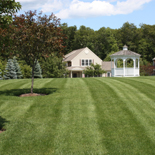 Struggling to get your garden looking how you envisioned it? Landscaping fabric can be an alternative option towards helping your garden flourish and grow wonderfully. The technology in landscaping fabric will provide your plants with the base for an environment which will require little to no weeding, meaning less maintenance for those part-time gardeners. While landscaping fabric presents a solution to a chore we all hate, the fabric should only be used in certain situations to get the best results.
Struggling to get your garden looking how you envisioned it? Landscaping fabric can be an alternative option towards helping your garden flourish and grow wonderfully. The technology in landscaping fabric will provide your plants with the base for an environment which will require little to no weeding, meaning less maintenance for those part-time gardeners. While landscaping fabric presents a solution to a chore we all hate, the fabric should only be used in certain situations to get the best results.
When is Landscaping Fabric the Right Choice?
Landscaping fabric can provide your garden with a protective base to help stop the growth of weeds around your plants. Typically landscaping fabric will last about ten years, however this fabric is not designed for all types of gardens. In order to have the most success landscaping fabric should be used on newer gardens that are made up of shrubs, ornamental grass, heathers, and strong perennials. The reasoning behind this is that these types of plants do not require as much nutrients and although landscaping fabric provides great protection, it does poorly in providing any type of nutritional value to the plant. Due to this, adding a layer of mulch and wood chips is important in making sure a sufficient amounts of nutrients are still getting absorbed by the plants in your garden.
Landscaping fabric is also used is to help prevent erosion when a garden lays along an edge or on top of a hill. The fabric provides more of a support than just soil and latches on, thus keeping everything in place. Lastly, dog owners know just how much their pets love to dig and consequently leave holes everywhere. Landscaping fabric is tough enough to where it can prevent your dog from digging up a plant and uprooting it.
Materials Needed
Installation of landscaping fabric will require these materials.
- Landscape Fabric- Provides a weed barrier (sold in different sizes).
- Pins- Holds down the fabric leaving a non-baggy surface (based on the size of the garden more pins are needed).
- Compost/ Organic matter- Provides nutrients for the plants.
- Mulch/ Wood chips- Protects against weed growth.
- Any cutting edge- Used to cut holes in the fabric for plants.
The Installation Process
The installation process for landscaping fabric is fairly easy, however for the best results consider having a professional come and do the job. Before placing any fabric down consider adding any compost or organic matter you may have as this will help nutrients reach the roots of plants. The fabric must then be laid out and cut into the desired shape and size. Next the pinning process can begin. Pins should be placed throughout the edges of the fabric and anywhere two pieces will meet to ensure no weeds will be getting through. Remember that by pinning the fabric tightly you will see better results. Holes should then be cut in the fabric where plants will be positioned. These holes should be large enough for the plant without leaving any extra space for weeds to sneak through. Once complete you can then add a top layer of mulch and/or wood chips about 3” thick to anchor the plant and hide any fabric showing.
As professional landscapers, Greener Horizon recognizes the importance of high quality materials in all landscaping projects, both large and small. That is why we are committed to providing our community with a variety of top-notch materials, available to contractors and homeowners alike. If you are still considering the purchase of landscaping fabric for your garden or are in search of any other landscaping supplies click here. We can also help with delivery and installation.






